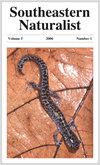两种食虫蝙蝠在雌性生殖关键时期的脱发
IF 0.6
4区 环境科学与生态学
Q4 BIODIVERSITY CONSERVATION
引用次数: 1
摘要
摘要:蝙蝠的脱发与多种应激因素有关,如体外寄生虫感染、环境污染物暴露、特发性疾病和生殖应激。在这里,我们注意到脱发发生在2种食虫蝙蝠,包括联邦濒危物种。2022年夏季,我们在美国田纳西州多个地点进行雾网和竖琴诱捕调查,发现3只大褐蝠(Eptesicus fuscus)和7只灰蝠(Myotis grisescens)患有脱发。10只出现秃斑的蝙蝠中,7只为哺乳期或哺乳期后的成年雌蝙蝠,1只为成年怀孕雌蝙蝠,2只为成年无生殖能力雄蝙蝠。尽管继续进行雾网和竖琴陷阱调查,但在哺乳期后或哺乳期后没有遇到脱发的蝙蝠。脱发的原因尚不清楚,需要进一步调查这些人群在生殖前(怀孕前)、生殖期(怀孕、哺乳期和精子发生)和生殖后(幼崽交配)时期的患病率。了解自然蜕皮周期与秃发作为个体压力的外在标志对于评估蝙蝠种群的健康至关重要。本文章由计算机程序翻译,如有差异,请以英文原文为准。
Alopecia in Two Species of Insectivorous Bats during the Critical Time Period of Female Reproduction
Abstract - Alopecia in bats has been related to multiple stressors, such as ectoparasite infestations, environmental contaminant exposure, idiopathic disease, and reproductive stress. Here we note occurrences of alopecia in 2 species of insectivorous bats, including a federally endangered species. In the summer of 2022, we encountered 3 Eptesicus fuscus (Big Brown Bat) and 7 Myotis grisescens (Gray Bat) with alopecia during mist-net and harp-trap surveys at multiple locations in Tennessee, USA. Seven of the 10 bats with bald spots were adult lactating or post-lactating females, 1 was an adult pregnant female, and 2 were adult nonreproductive males. No bats with alopecia were encountered after the lactation or post-lactation time period, despite continued mist-net and harp-trap surveys. The cause of the alopecia is unknown and warrants further investigation of prevalence across pre-reproductive (pre-pregnancy), reproductive (pregnancy, lactation, and spermatogenesis), and post-reproductive (pup volancy) periods in these populations. Understanding natural molt cycles versus alopecia as an outward sign of stress in individuals is critical for assessing the health of bat populations.
求助全文
通过发布文献求助,成功后即可免费获取论文全文。
去求助
来源期刊

Southeastern Naturalist
环境科学-生态学
CiteScore
1.20
自引率
16.70%
发文量
31
审稿时长
18-36 weeks
期刊介绍:
The Southeastern Naturalist covers all aspects of the natural history sciences of terrestrial, freshwater, and marine organisms and the environments of the southeastern portion of North America, roughly bounded from North Carolina south to Florida, west to Texas, north to Oklahoma, and east back to North Carolina. Manuscripts based on field studies outside of this region that provide information on species within this region may be considered at the Editor’s discretion.
 求助内容:
求助内容: 应助结果提醒方式:
应助结果提醒方式:


